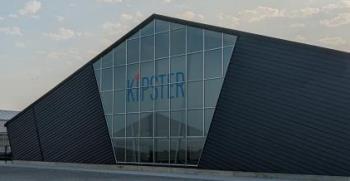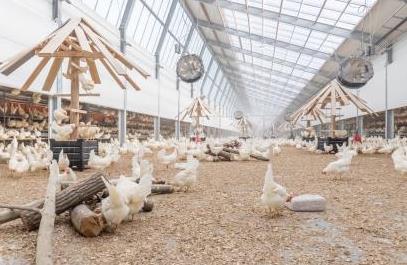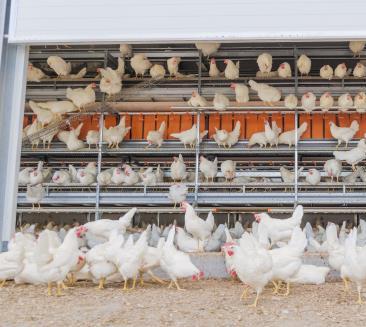 In 2017 entrepreneurs in Holland led by Ruud Zanders established the Kipster concept to enhance both sustainability and the welfare of laying hens. The company established a supply agreement with Lidl to exclusively market eggs produced under the system. Market demand in the Netherlands at the time and the perception of required egg-attributes by the founders influenced the design of housing and the procedures selected to produce Kipster eggs. The prototype house incorporated solar panels, skylights and a combination of indoor aviary modules, and an “indoor garden” Two “outdoor gardens” on either side of the building allowed liberal space requirements. Design features in the building and equipment were incorporated to conserve energy.
In 2017 entrepreneurs in Holland led by Ruud Zanders established the Kipster concept to enhance both sustainability and the welfare of laying hens. The company established a supply agreement with Lidl to exclusively market eggs produced under the system. Market demand in the Netherlands at the time and the perception of required egg-attributes by the founders influenced the design of housing and the procedures selected to produce Kipster eggs. The prototype house incorporated solar panels, skylights and a combination of indoor aviary modules, and an “indoor garden” Two “outdoor gardens” on either side of the building allowed liberal space requirements. Design features in the building and equipment were incorporated to conserve energy.
In keeping with the intent of the founders of Kipster, available recycled ingredients were specified for inclusion in feed for laying hens. This involved substitution of bakery waste for a proportion of corn and also meat and bone meal as a protein source (in the U.S.), sparing vegetable protein. In western Europe conventional diets include combinations of domestic and imported soybean meal, canola meal and sunflower meal as contributors to protein and hence amino acid requirements.
Based on prevailing sentiment in 2018, the Kipster concept required grow-out of cockerel chicks that would otherwise have been destroyed at the time that sister pullets were hatched. This requirement is now unnecessary in the E.U. given the advent of commercial gender-sorting of eggs bearing either male or female embryos at or before nine days of incubation. The requirement for grow-out of cockerels imposes additional cost and is contrary to optimal sustainability but is retained in the U.S. model.

In 2020, the Kroger Company obtained a franchise for the Kipster model in the U.S. Whether the Nation’s second-ranked retailer in egg sales actually evaluated the financial aspects in addition to marketing considerations is doubtful for other than a specialty niche. The question arises as to whether the claimed sustainability and welfare aspects are in reality recognized by consumers who will be willing to pay a premium for these non-quantifiable attributes. Will the Kipster image generate a preferential margin over the long term in comparison to available specialty eggs including nutritionally enriched, free range, pasture-reared and other variations?
The Purdue University Consumer Food Insights (Volume 2, issue 8) recently conducted a survey involving 2,500 respondents on their ranking of motivation to select specific food products. The Purdue University investigators applied conjoint analysis using orthogonal comparisons to differentiate among attributes and establish a real understanding of motivation. Using pork as an example, the relative weighting among 100 points leading to a purchase decision included:-

- Price, 23;
- Taste, 22;
- Freshness, 18;
- Nutritional value, 14;
- Appearance, 11;
- Welfare, 7;
- Sustainability, 5.
While it is acknowledged that the study was conducted on pork and not on eggs, the low ranking of both welfare and sustainability in relation to price and taste are noteworthy. Is it questioned whether Lidl in Holland or Kroger in the U.S. consider that a limited but affluent demographic will preferentially adopt the Kipster Brand that offers claimed welfare and sustainability in preference to competitive cage-free production systems. A second consideration is whether the presence of Kipster eggs in a store cooler provides a halo effect, extending the perception of added welfare and sustainability to conventional store-branded eggs?
The impression gained from the Kipster website and the history and adoption of the Kipster model suggests that a bottom-up approach was used by the developers to maximize sustainability and welfare as the bedrock of the concept. In contrast, a more realistic approach for the U.S. would have been to determine the needs of a broad range of consumers and adopt a system that satisfies the desired attributes of price, taste, freshness and nutritional value. This was the basis of the Nation’s widely accepted nationally distributed brand over 30 years ago.
In 2019 Kroger approached MPS Egg Farms, a large and progressive existing egg supplier, to establish a Kipster production unit in the U.S. The basic house as designed and erected in Holland was slightly modified. MPS erected and now operates four houses in North Manchester, Indiana. It is noted that in Holland there are only three Kipster houses currently producing eggs with the initial house on one farm and two houses on a second. The MPS farm with four houses effectively exceeds the number erected in Holland over a five-year period. This raises the question of whether the concept provides a satisfactory return that would have encouraged individual farmers and investors to adopt the model. The Kipster concept is reminiscent of the 2009 Rondeel Concept developed jointly by Vencomatic and Wageningen University. The system was widely promoted and supported by the Albert Heijn supermarket chain, a subsidiary of Ahold-Delhaize. Only a handful of Rondeel units were erected and placed into production.
The MPS Kipster complex comprises four houses each holding 24,000 hens. Each house comprises two longitudinal ‘night-time’ areas with total of 24,212 square feet allowing 1.01 square foot per hen. An “indoor garden” 358 by 33 feet allowing 1.00 square foot per hen is located midway in the house between the night-time areas. Drop-down doors can be closed to confine flocks to the two “night-time” areas The ‘indoor garden has skylights for natural daylight and incorporates artificial trees for roosting, hay-bales and other enrichments on a base of wood shavings. Two “outdoor gardens” are provided each 32 feet wide parallel with each side of the house providing 1.0 square feet of exterior access per bird. The enclosed area of a Kipster house provides 1.61 square feet per hen and the outside area comprises 0.94 square feet.
 The ‘night-time’ areas are equipped with Big Dutchman Natura® Step Cages equipped with feeders and nipple drinkers. The communal nest system incorporates tilting floors, center rollaway collection and additional side belts for system-laid eggs to optimize the yield of clean shells. Big Dutchman provided an OptiSec Manure Drying System that contributes to sustainability by reducing the moisture content of manure to 10 to 15 percent depending on ambient temperature. Big Dutchman also supplied an Innoplus Exhaust Air Scrubber to remove dust and odors from the exhaust stream consistent with western European requirements, although of questionable need for the U.S.
The ‘night-time’ areas are equipped with Big Dutchman Natura® Step Cages equipped with feeders and nipple drinkers. The communal nest system incorporates tilting floors, center rollaway collection and additional side belts for system-laid eggs to optimize the yield of clean shells. Big Dutchman provided an OptiSec Manure Drying System that contributes to sustainability by reducing the moisture content of manure to 10 to 15 percent depending on ambient temperature. Big Dutchman also supplied an Innoplus Exhaust Air Scrubber to remove dust and odors from the exhaust stream consistent with western European requirements, although of questionable need for the U.S.
According to Sam Krouse CEO of MPS, performance from the initial placements is comparable with aviaries and other cage-free systems. With acceptable U.S. production parameters, average output is 200 cases per day. Neither capital investment per hen nor production costs including feed, labor and power have been disclosed. Estimates of capital costs suggest a higher unit price per hen compared a conventional aviary system operated at UEP density. Any differential will be reflected in the fixed component of production costs. It is noted that the entire farm of four houses is effectively equivalent to one level of a typical U.S. multi-level (two to four) aviary house with a single foundation and roof. Labor cost is proportionately higher with four relatively small houses compared to an in-line aviary house. There is no indication of the price of feed that is a major component of variable cost. Bakery waste with xylanase and amino acid supplementation would probably be equivalent in price to corn. Animal byproduct meal is included in laying diets based on the need to incorporate “recycled ingredients”. There is a decided consumer preference for all-vegetable diets that has become the standard for U.S. specialty eggs.
It is frequently difficult to transfer concepts that may be acceptable and financially beneficial at a point in time in a nation to a completely different operating and marketing environment without considerable adaptation and a required degree of flexibility. A few years ago the significant U.S. marketer of specialty eggs was approached by a consortium of Japanese producers to license the concept for their nation. Investigation of the needs of the market in Japan, prevailing production costs and numerous technical restraints that emerged required such extensive modification of the U.S. program that the initiative was abandoned.
While it is too early to evaluate the Kipster concept with respect to the U.S. it certainly has not blown out the doors in Holland over the past five years. Development of the system in a highly competitive market such as the U.S. will probably confine adoption to a specific niche. Based on current consumer motivation, any novel U.S. egg concept would rank price, commensurate with quality and freshness above the attributes of sustainability and welfare. Nutritional value and safety would also be highly ranked. Accordingly, the structure of an enterprise, the design of housing, specification of equipment, formulation and sourcing of feed and selection of packaging would all be conditioned by the needs of the market.
At the end of the day Kroger could not have picked a better partner than MPS to develop the first Kipster operation in the U.S. The question remains as to how both Kipster and their licensee Kroger, will expand the concept to supply other U.S. regions with eggs. There is no indication of how Kroger will promote sustainability and welfare against USDA certified organic and other cage-free and pasture-housed products. It is also questioned whether Kroger will be willing to pay a premium to producers to cover the additional fixed and variable costs of nest-run production in comparison to alternative cage-free housing systems. Certainly if margins justify the difference over the intermediate term but unless either Kroger or Kipster are willing to spend on promoting the concept on mainstream and social media growth will be limited in a competitive market.